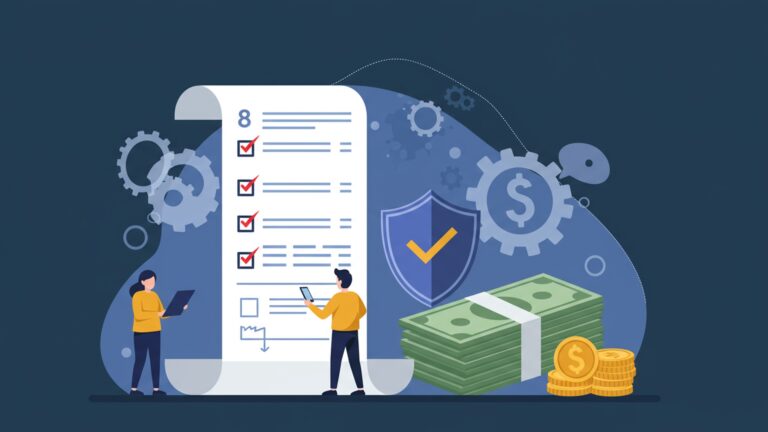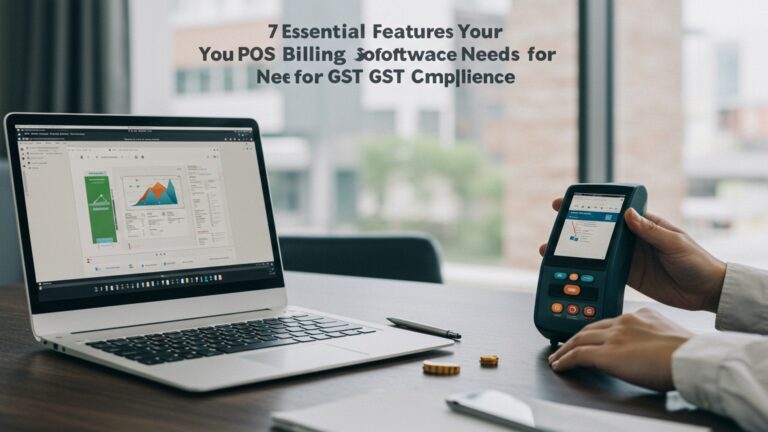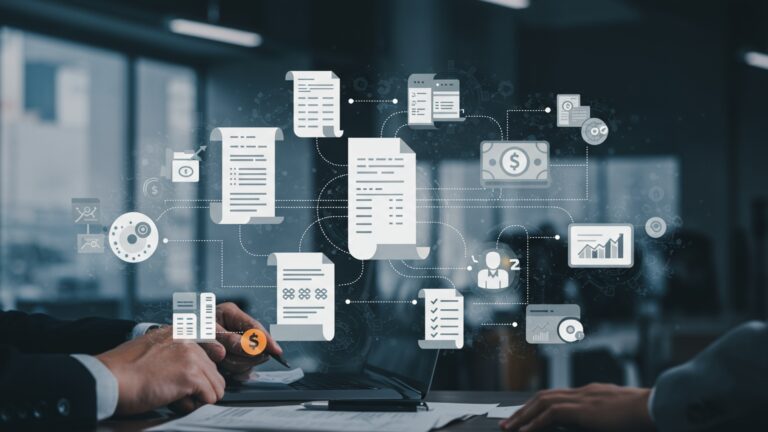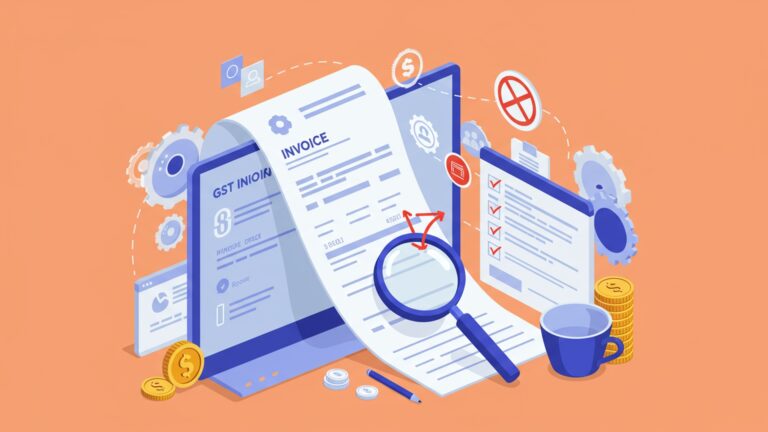5 Best Practices for Seamless GST Invoicing Learn to Avoid Common Mistakes
Navigating the intricate world of GST demands precision, especially when it comes to invoicing. Businesses frequently encounter costly pitfalls, from inadvertently misclassifying HSN codes to applying incorrect tax rates, which can trigger compliance notices, delay crucial input tax credits. invite stringent audits. With e-invoicing now mandatory for a significant portion of businesses, the shift towards digital accuracy amplifies the need for robust processes. Mastering effective GST invoicing tips is no longer just about avoiding penalties; it strategically enhances cash flow, streamlines reconciliation. fortifies your audit readiness. Proactive implementation of best practices transforms a potential compliance burden into a competitive operational advantage, ensuring every transaction aligns perfectly with regulatory requirements.

Understanding the Fundamentals of GST Invoicing
In the world of Goods and Services Tax (GST), accurate invoicing is not just a formality; it’s the backbone of your business’s financial compliance and health. At its core, GST is a consumption-based tax levied on the supply of goods and services. For businesses, issuing a valid GST invoice is paramount for several reasons: it enables the recipient to claim Input Tax Credit (ITC), ensures proper tax collection for the government. serves as a legal document for every transaction. Without a correct invoice, claiming ITC becomes impossible, leading to increased costs and potential penalties during audits.
A valid GST invoice, as per the GST law, must contain specific mandatory fields. Missing or incorrect details in these fields are common missteps that can lead to significant issues. Here are the key components:
- Invoice Number and Date
- Supplier’s Details
- Recipient’s Details
- HSN Code for Goods / SAC Code for Services
- Description of Goods/Services
- Quantity and Unit
- Value of Supply
- Applicable Tax Rate
- Amount of Tax
- Place of Supply
- Signature
A unique, sequential invoice number (not exceeding 16 characters) and the date of issue.
Legal name, address. GSTIN (Goods and Services Tax Identification Number) of the supplier.
Legal name, address. GSTIN of the recipient (if registered). If the recipient is unregistered and the value is above INR 50,000, their name and address are still required.
Harmonized System of Nomenclature (HSN) for goods and Services Accounting Code (SAC) for services.
Clear and concise details of what is being supplied.
For goods, the quantity and unit (e. g. , 10 pieces, 5 kg).
The taxable value of goods or services.
The rate of CGST, SGST/UTGST, or IGST.
The actual tax amount charged for each component.
State name of the recipient (for inter-state supplies, required even if the recipient is unregistered).
Digital or physical signature of the supplier or an authorized representative.
Common mistakes often stem from overlooking these basic details. For instance, sometimes businesses forget to include the recipient’s GSTIN, or they use an incorrect HSN code. These seemingly small errors can lead to the rejection of ITC claims for your customers, straining business relationships and potentially triggering compliance notices. One of the best GST invoicing tips for beginners is to create a standardized invoice template that includes all mandatory fields. This ensures consistency and significantly reduces the chance of oversight.
Leveraging Technology for Error-Free Invoicing
In the digital age, relying solely on manual invoicing methods is not only inefficient but also a breeding ground for errors. Manual processes, whether using spreadsheets or handwritten invoices, are prone to human mistakes such as calculation errors, incorrect data entry, or omissions of mandatory fields. Imagine a small business, ‘Crafty Creations,’ manually calculating GST for hundreds of daily transactions. The likelihood of errors in tax rates, HSN codes, or total amounts is incredibly high, leading to reconciliation nightmares and potential tax liabilities.
This is where GST-compliant invoicing software becomes indispensable. These platforms automate the entire invoicing process, significantly reducing the scope for human error. When ‘Crafty Creations’ switched to an automated invoicing system, they found that their error rate dropped by over 90%. The system automatically applied correct tax rates based on HSN/SAC codes, calculated CGST/SGST or IGST accurately. generated professional-looking invoices with all mandatory fields pre-filled or easily selectable.
When selecting invoicing software, look for features that directly address common pain points:
- Automated Tax Calculation
- HSN/SAC Code Management
- E-invoicing Integration
- E-Way Bill Generation
- Reporting and Reconciliation
- Data Validation
The software should automatically calculate CGST, SGST, IGST. cess based on the HSN/SAC code and place of supply.
A robust database of HSN/SAC codes that allows for easy selection and application.
Seamless generation of e-invoices directly from the software, including IRN and QR code.
Integration with the E-Way Bill portal for quick generation for goods in transit.
Tools to generate GST returns (GSTR-1, GSTR-3B) and reconcile data.
Automated checks for GSTIN validity, HSN code accuracy. other mandatory fields.
Consider the comparison between manual and automated invoicing:
| Feature | Manual Invoicing (e. g. , Excel/Paper) | Automated Invoicing Software |
|---|---|---|
| Accuracy | High risk of human errors (calculation, data entry) | Minimised errors, automated calculations |
| Time Efficiency | Time-consuming for data entry and calculations | Fast generation, bulk operations possible |
| Compliance | Requires manual checks for mandatory fields, prone to missing details | Ensures all mandatory fields are present, prompts for missing data |
| Reconciliation | Complex and tedious, high chance of discrepancies | Simplified reconciliation with automated reports |
| E-invoicing/E-Way Bill | Separate, manual process on government portals | Integrated generation, streamlined workflow |
| Cost (Indirect) | Potential penalties, lost ITC due to errors | Reduced compliance risk, efficient ITC management |
Adopting technology is one of the most effective GST invoicing tips for businesses looking to scale and ensure compliance. It frees up valuable time, reduces stress. provides a clear audit trail.
Mastering HSN/SAC Codes and Tax Rates
The Harmonized System of Nomenclature (HSN) for goods and Services Accounting Code (SAC) for services are crucial classifications mandated under GST. These codes standardize the classification of goods and services globally, making tax assessment uniform and reducing disputes. Each HSN/SAC code is linked to a specific GST rate, meaning accurate classification directly impacts the tax charged on your supplies. For instance, a particular type of fabric might have a different HSN and GST rate than another, slightly different fabric. Applying the wrong code means charging the wrong tax, which can lead to either overpaying or underpaying taxes, both of which have adverse consequences.
Common mistakes in this area include:
- Incorrect HSN/SAC Application
- Missing HSN/SAC Codes
- Applying Wrong Tax Rates
Using a code that doesn’t accurately describe the goods or services supplied. This often happens with products that have slight variations or services that can be categorised in multiple ways.
Forgetting to include the HSN/SAC code on the invoice, especially for businesses with turnover exceeding specified thresholds. As per current regulations, businesses with an annual aggregate turnover of more than INR 5 crore must mention 6-digit HSN codes for both B2B and B2C supplies. For those with a turnover up to INR 5 crore, 4-digit HSN codes are required for B2B supplies.
Charging a 12% GST when the correct rate is 18%, or vice-versa, due to an incorrect HSN/SAC code or simply a manual error.
The impact of these errors is significant. An incorrect HSN/SAC code can lead to your customer being denied their Input Tax Credit (ITC) because the tax authority might deem the invoice invalid. For your business, it could result in demand notices for short payment of tax or, conversely, a refund claim for overpayment, both of which are administrative burdens. To correctly identify HSN/SAC codes, refer to the official CBIC (Central Board of Indirect Taxes and Customs) website or the GST portal’s HSN/SAC search functionality. These resources provide detailed lists and search tools to help you classify your items accurately.
Here are some essential GST invoicing tips for mastering HSN/SAC codes and tax rates:
- Regularly Update Your Product/Service Database
- Stay Informed on Changes
- Consult Experts
- Use Integrated Software
Ensure that every item or service you offer has the correct HSN/SAC code and corresponding GST rate assigned in your invoicing system.
GST rates and HSN/SAC classifications can change. Follow official GST news and notifications from CBIC and the GST Council to ensure your system is always up-to-date.
If you deal with complex goods or services, consider consulting a GST professional to help you correctly classify them.
Modern GST software often comes with built-in HSN/SAC databases and automates rate application, significantly reducing manual errors.
By diligently managing HSN/SAC codes and tax rates, businesses can ensure compliance, avoid penalties. facilitate seamless ITC for their clients.
The Nuances of E-Invoicing and E-Way Bills
E-invoicing under GST is not merely sending invoices via email; it’s a system where businesses upload their invoices to the Invoice Registration Portal (IRP), which then validates and issues an Invoice Reference Number (IRN) and a digitally signed QR code. This system aims to standardize invoice data, reduce data entry errors. facilitate real-time reporting to the GST system. E-invoicing is mandatory for businesses exceeding specific aggregate annual turnover thresholds (currently INR 5 crore from August 1, 2023, for B2B transactions).
The benefits of e-invoicing are manifold:
- Reduced Data Entry Errors
- Faster ITC
- Simplified Reconciliation
- Reduced Fraud
Standardized format minimises manual data entry at various points.
Real-time reporting makes ITC verification quicker for recipients.
Auto-population of GSTR-1 and GSTR-2A/2B simplifies return filing and reconciliation.
Unique IRN and QR code make invoice duplication and fraud difficult.
The process of generating an e-invoice typically involves your accounting/ERP software pushing invoice data to the IRP, which then returns the IRN and QR code. This QR code, when scanned, provides key details of the invoice, including the IRN. Common mistakes include data mismatch between the invoice and the data uploaded to IRP, generating invoices for applicable transactions without an IRN, or using an invalid IRN. For example, ‘Tech Solutions Pvt. Ltd.’ once uploaded an invoice to the IRP with an incorrect amount due to a manual error in their ERP, leading to a mismatch with the actual invoice sent to the client. This required cancellation and re-issuance, causing delays.
Complementing e-invoicing is the E-Way Bill system. An E-Way Bill is an electronic document required for the movement of goods worth more than INR 50,000 (with some exceptions) from one place to another, whether inter-state or intra-state. It ensures that goods in transit are compliant with GST regulations. The E-Way Bill system is integrated with the e-invoicing system; often, details from an e-invoice can be used to pre-fill parts of an E-Way Bill.
Here are crucial GST invoicing tips to ensure seamless e-compliance:
- Integrate Your Systems
- Validate Data Pre-Upload
- comprehend Applicability
- Train Your Team
Use invoicing software that has direct API integration with the IRP for e-invoice generation and the E-Way Bill portal.
Implement internal checks to ensure all data points on your invoice (GSTINs, HSN/SAC, amounts) are accurate before generating an e-invoice.
Be clear about when e-invoicing and E-Way Bills are mandatory for your business. For instance, an e-invoice is required even for B2C transactions if your aggregate turnover exceeds INR 500 crore (voluntary adoption for others), though B2C typically doesn’t require an IRN.
Ensure your invoicing and logistics teams are well-versed in the e-invoicing and E-Way Bill generation processes.
An example of a streamlined e-invoice generation flow:
1. Business creates an invoice in their ERP/accounting software. 2. Software extracts mandatory invoice data and converts it into JSON format. 3. JSON data is sent to the Invoice Registration Portal (IRP) via API. 4. IRP validates the data against GST records. 5. If valid, IRP generates a unique Invoice Reference Number (IRN) and digitally signs the invoice. 6. IRP embeds a QR code with IRN and other key details onto the invoice. 7. IRP sends the digitally signed e-invoice back to the business's software. 8. Business can then generate an E-Way Bill using the e-invoice data (if applicable). 9. Business sends the e-invoice (with IRN and QR code) to the recipient.
This automated flow ensures accuracy and speeds up the entire compliance process.
Regular Reconciliation and Audit Preparedness
Even with the best invoicing practices and technology, discrepancies can arise. This is why regular reconciliation is a non-negotiable best practice for GST compliance. Reconciliation involves matching the data reported in your various GST returns (GSTR-1, GSTR-3B) with your internal books of accounts and with the data reflected in your GSTR-2A/2B (which shows purchases as reported by your suppliers). The goal is to identify and resolve any mismatches, ensuring that the tax you’ve paid, collected. claimed as ITC is accurate and consistent across all records.
For example, ‘Apex Distributors’ faced a situation where their GSTR-3B showed a higher ITC claim than what was reflected in their GSTR-2A. Upon reconciliation, they discovered that one of their key suppliers had failed to upload an invoice in their GSTR-1. Prompt communication with the supplier resolved the issue, preventing a potential ITC reversal notice during an audit.
Common reconciliation errors and how to fix them:
- Mismatch in ITC Claimed (GSTR-3B vs. GSTR-2A/2B)
- Cause
- Fix
- Mismatch in Outward Supplies (GSTR-1 vs. GSTR-3B)
- Cause
- Fix
- Mismatch between Books of Accounts and GST Returns
- Cause
- Fix
Supplier not uploading invoice, incorrect GSTIN in supplier’s return, wrong tax period mentioned by supplier.
Contact supplier to rectify their GSTR-1 or upload missing invoices. Adjust your ITC claim if the supplier doesn’t cooperate.
Data entry error, accidental omission of invoices in one return.
Identify the discrepancy and amend the relevant return in the subsequent filing period.
Errors in accounting software setup, manual data entry mistakes, misclassification of transactions.
Conduct a thorough ledger scrutiny, ensure proper mapping of accounts to GST categories. rectify internal records.
Maintaining proper records is equally vital. While digital records are increasingly preferred for their searchability and security, keeping physical copies of critical documents like original invoices (especially for high-value transactions) can still be a good practice. Ensure your digital records are backed up securely and are easily retrievable.
Preparing for GST audits means having your house in order. Auditors typically look for:
- Consistency between GSTR-1 and GSTR-3B.
- Justification for ITC claims, especially matching with GSTR-2A/2B.
- Correct application of HSN/SAC codes and tax rates.
- Proper documentation for reverse charge mechanism (RCM) transactions.
- Validity of e-invoices and E-Way Bills.
- Timely payment of tax liabilities.
As per a statement by a senior tax consultant, “Proactive reconciliation is your best defence against audit queries. It’s far easier to correct a mistake internally than to explain it under scrutiny.”
Here’s an actionable checklist for audit readiness, incorporating key GST invoicing tips:
- Maintain a detailed sales register with all invoice particulars.
- Keep a purchase register with supplier GSTINs, invoice numbers. ITC details.
- Regularly reconcile GSTR-1 with GSTR-3B.
- Match your GSTR-3B ITC claims with GSTR-2A/2B monthly.
- Ensure all e-invoices have valid IRNs and QR codes.
- Keep records of all E-Way Bills generated and received.
- Have clear documentation for any adjustments or amendments made in returns.
- Retain all supporting documents for ITC claims, including vendor invoices.
- Ensure your accounting software is regularly updated and configured correctly.
Conclusion
Mastering seamless GST invoicing is no longer just about compliance; it’s a strategic imperative for operational efficiency and financial health. With the expanding ambit of e-invoicing for businesses of all sizes, embracing digital solutions and understanding the nuances of accurate data entry, from HSN codes to supplier GSTINs, has become paramount. I’ve personally seen how a proactive approach, especially leveraging integrated POS and billing software, drastically reduces errors that often lead to penalties and reconciliation nightmares, turning a tedious task into a streamlined process. To truly excel, I encourage you to make a habit of quarterly internal audits, cross-referencing your GSTR-1 with GSTR-3B. investing in continuous training for your team on the latest GST updates. This isn’t merely about avoiding common mistakes; it’s about transforming your invoicing process into a reliable data source that informs better business decisions and strengthens your cash flow. By staying vigilant and embracing technology, you’re not just filing taxes; you’re building a resilient, transparent. more profitable business for the future.
More Articles
Your Complete Guide to Integrated Billing and POS Software
Learn How Smart POS Billing Software Boosts Business Efficiency
7 Essential Invoice Best Practices to Get Paid Faster and Improve Cash Flow
Uncover the Best POS Software in India for Small Businesses
FAQs
Why is it so essential to get GST invoicing right?
Getting GST invoicing spot-on is crucial for a few reasons. It ensures you stay compliant with tax laws, helps your customers claim their input tax credit smoothly. prevents you from facing penalties or audits. , it keeps your business out of hot water and running efficiently.
What are the most common mistakes people make when creating GST invoices?
Oh, there are quite a few! Common slip-ups include entering incorrect GSTINs, using the wrong HSN/SAC codes, miscalculating tax amounts, forgetting to include mandatory details, or issuing invoices late. These small errors can lead to big problems down the line.
How can I make sure my GST invoices are always accurate and follow all the rules?
The best way is to double-check everything! Verify GSTINs, cross-reference HSN/SAC codes. ensure all mandatory fields are filled correctly. Using reliable GST-compliant invoicing software can automate calculations and flag potential errors, significantly boosting accuracy.
Is there a trick to making GST invoicing less of a headache and more seamless?
Absolutely! The biggest trick is to adopt good invoicing software. It automates much of the process, from calculating taxes to generating correct formats. Establishing a clear internal process for invoice creation and review also helps a lot, making it a smooth, repeatable task rather than a last-minute scramble.
What should I do if I’ve already issued an invoice with a mistake?
Don’t panic! For most errors, you’ll need to issue a Credit Note or a Debit Note, depending on whether the original invoice amount needs to be reduced or increased. Always correct mistakes promptly to ensure your records match your customer’s and to avoid issues during GST return filing.
Any tips for keeping track of all my GST invoices and records effectively?
Definitely. Digital record-keeping is a lifesaver. Store all your invoices electronically in a systematic way, ideally through your invoicing software or a cloud-based system. Regularly reconcile your sales and purchase invoices with your GST returns to catch any discrepancies early.
Why is using good invoicing software considered a best practice for GST?
Good invoicing software is a game-changer because it automates complex calculations, ensures all mandatory fields are included. keeps your invoices compliant with the latest GST rules. It drastically reduces manual errors, saves a ton of time. provides a clear audit trail, making your entire GST compliance journey much easier.






